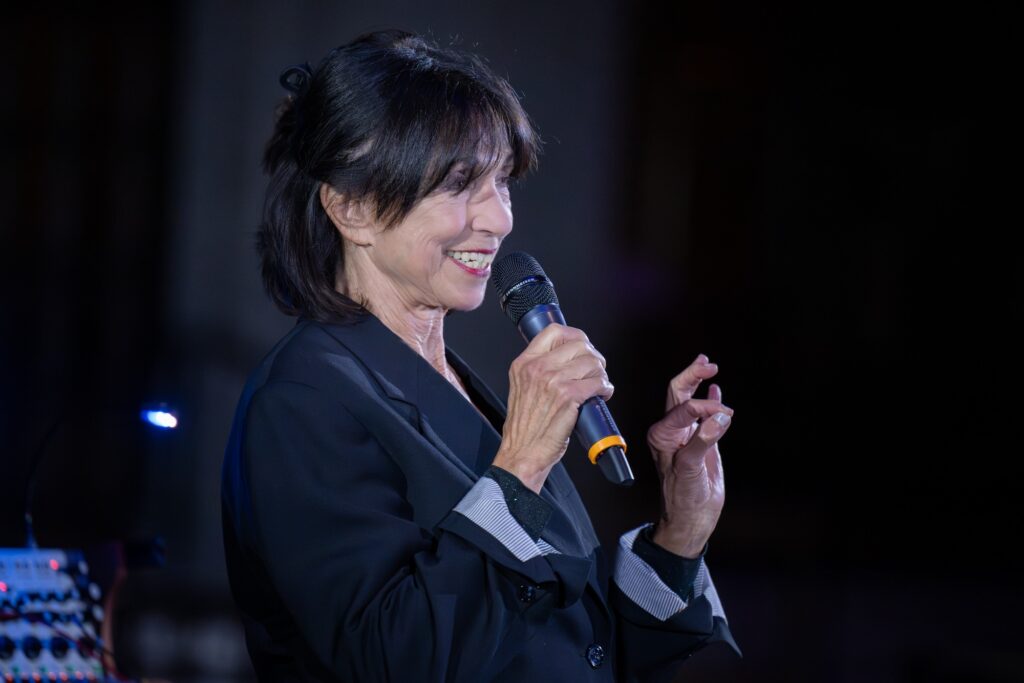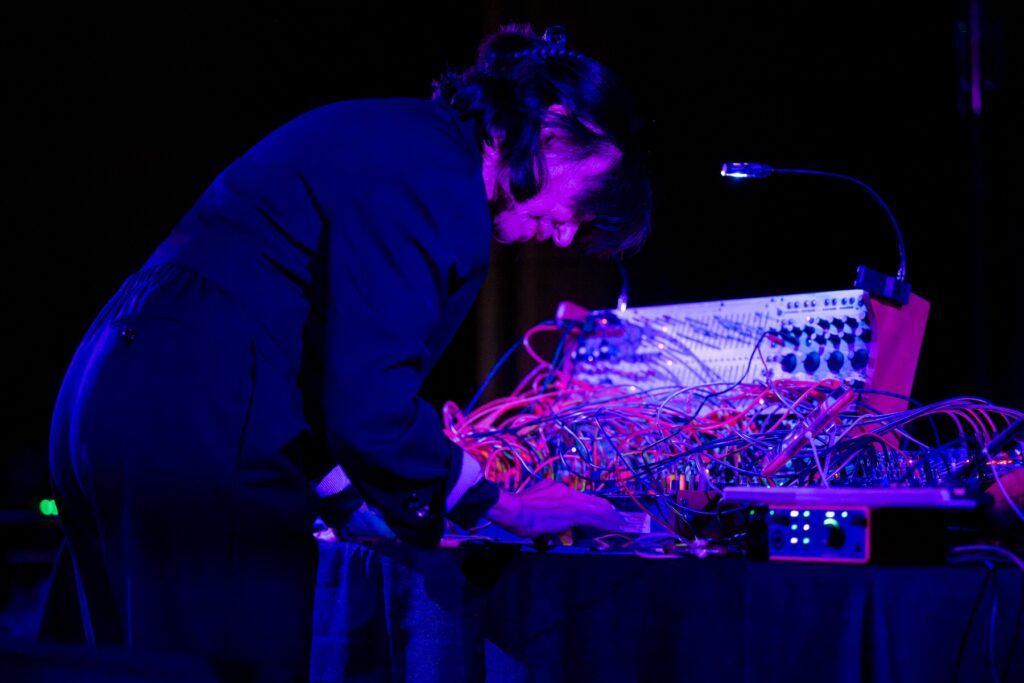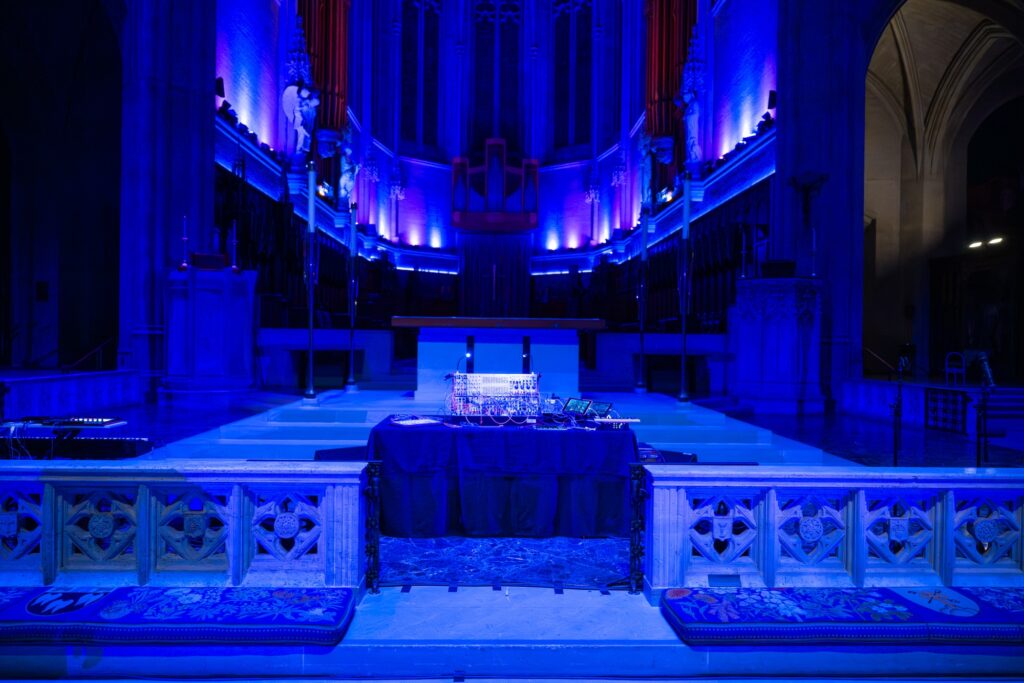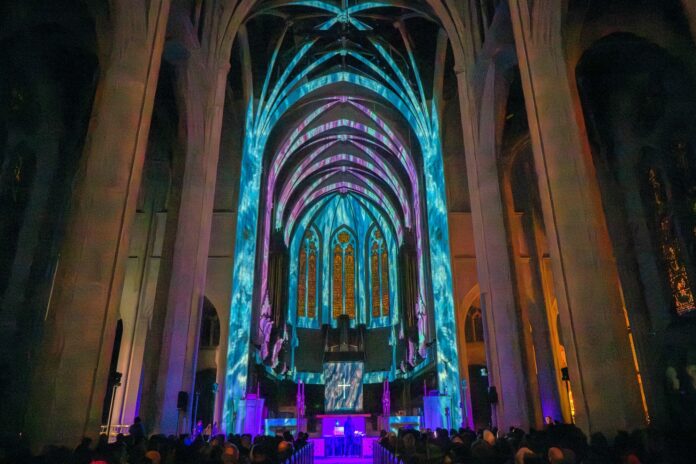The ocean waves seemed to literally roll down the aisles of Grace Cathedral during Suzanne Ciani’s Noise Pop set, Feb 24. Combined with visuals that drowned the entire space in deep blue with glimmers of gold, the overall impression was of a post-human future in which the ocean had risen up to consume the church’s mighty architecture. With the space bathed in darkness, Ciani nearly invisible, and the ceiling 100 feet above the audience, there was nowhere to look but up. At times, it was easy to forget there was even anyone else in the building despite the pews of the vast space being completely filled.
Grace Cathedral has long been a sanctuary for experimental music. Among its greatest claims to fame is being the site of Duke Ellington’s First Sacred Concert in 1965, whose live recording is for my money one of the greatest albums of the 1960s. Artists who’ve performed in the past include free-jazz legends John Zorn, Cecil Taylor, and Pharoah Sanders. A Ghost Ship memorial concert in 2017, which I attended, brought Butoh dancers to its famous labyrinth along with an assortment of avant-garde musicians. It’s now the venue for some of Noise Pop’s most interesting shows, including Mountain Goats and Mount Eerie this year. Steve Roach, an ambient legend and a contemporary of Ciani’s, will perform April 6.

Ciani began her set by announcing that her debut album Seven Waves was celebrating its 40th anniversary. “She’s an OG!,” exclaimed the bearded twentysomething in the seat next to me; he seemed to have never heard of her, in which case he would undoubtedly be impressed to know that this was actually the album’s 42nd anniversary. It was released in Japan two years ahead of its American release, allegedly due to stateside labels having no idea what to do with a female composer who didn’t sing—and despite Ciani having already been on David Letterman, contributed to Starland Vocal Band’s “Afternoon Delight” and Meco’s Star Wars disco medley, and rubbed elbows with downtown NYC minimalists like Steve Reich and Phill Niblock in the 1970s. She’s now 77 and has lived in Bolinas for nearly three decades, notably collaborating in recent years with the younger synth whiz Kaitlyn Aurelia Smith.
Ciani seemed slightly reluctant to perform the material from Seven Waves, which she claimed had been incorporated into the set at the suggestion of her manager. What she was really there for was the Buchla improvisations. The Buchla is a famously idiosyncratic synth, designed by Bay Area electronics guru Don Buchla in the early ‘70s, and much of Ciani’s material is composed on it, including the ocean waves rolling through Grace Cathedral, which sound for all the world like real ocean samples. (If you’re old enough to remember the Coca-Cola “pop ’n’ pour” sound effect from ‘70s advertising, that was Ciani’s Buchla.)

The Seven Waves portions of the set situated us comfortably in the universe of mid-‘80s New Age, when the traditions pioneered by Brian Eno and Tangerine Dream were hitting an artistic peak and the post-club style of ambient associated with the KLF and the Orb was still a few years away. The Buchla portions launched off the face of the earth for another adventure entirely, sometimes resembling hoofbeats, barking dogs, chirping birds, and chattering insects in addition to ocean waves. (The guy next to me cracked up whenever she made a particularly weird synth noise.) This was less “ambient” music than a frightening excursion into pure sound, the quadraphonic skitters across the stereo field suggestive of a moving and potentially dangerous presence.
Anyone who saw Ciani posing on the cover of Seven Waves, bathed in blue lightwith a siren smile, and expected an evening of cheesy retro synth music must have had their horizons considerably rejiggered. For that matter, anyone expecting her neo-classical music would’ve been infuriated. Ciani spent years making piano records, finding considerable success and recognition on the new-age circuit without necessarily being known for her experimental history. It’s only in more recent years, with a renewal of interest in vintage synth music and a critical 180 on new age, that younger audiences have started to see Ciani as a pioneer—and that she’s been able to play music this weird for crowds this big.

After thoroughly rearranging the audience’s minds, Ciani encouraged the audience to say hi: not to her, but to the Buchla. Indeed, Ciani’s own post-show presence went largely ignored in favor of her machine, which lay somewhat sacrilegiously on the church podium, beckoning to audience members with its flashing lights. It looks like something you’d find on the deck of the Enterprise, byzantine to most casual observers, with an endless tangle of knobs and wires in place of a keyboard. Yet Ciani speaks of the Buchla as a friend, constant companion, even a lover—and if you look at it long enough, it does seem to take on a strange intelligence of its own.





